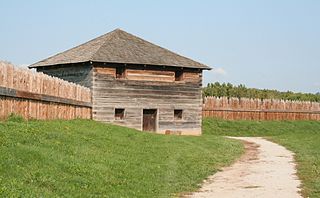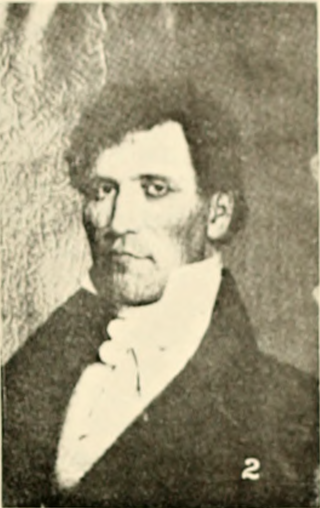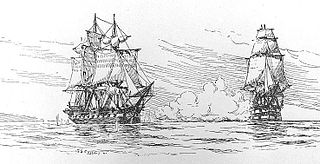
The War of 1812 was fought by the United States and its indigenous allies against the United Kingdom and its own indigenous allies in British North America, with limited participation by Spain in Florida. It began when the United States declared war on 18 June 1812. Although peace terms were agreed upon in the December 1814 Treaty of Ghent, the war did not officially end until the peace treaty was ratified by Congress on 17 February 1815.

1814 (MDCCCXIV) was a common year starting on Saturday of the Gregorian calendar and a common year starting on Thursday of the Julian calendar, the 1814th year of the Common Era (CE) and Anno Domini (AD) designations, the 814th year of the 2nd millennium, the 14th year of the 19th century, and the 5th year of the 1810s decade. As of the start of 1814, the Gregorian calendar was 12 days ahead of the Julian calendar, which remained in localized use until 1923.

Farnham is a market town and civil parish in Surrey, England, around 36 miles (58 km) southwest of London. It is in the Borough of Waverley, close to the county border with Hampshire. The town is on the north branch of the River Wey, a tributary of the Thames, and is at the western end of the North Downs. The civil parish, which includes the villages of Badshot Lea, Hale and Wrecclesham, covers 14.1 sq mi (37 km2) and had a population of 39,488 in 2011.

The Battle of Plattsburgh, also known as the Battle of Lake Champlain, ended the final British invasion of the northern states of the United States during the War of 1812. Two British forces, an army under Lieutenant General Sir George Prévost and a naval squadron under Captain George Downie converged on the lakeside town of Plattsburgh, New York. Plattsburgh was defended by New York and Vermont militia and detachments of regular troops of the United States Army, all under the command of Brigadier General Alexander Macomb, and ships commanded by Master Commandant Thomas Macdonough.

The Battle of Alton, of the First English Civil War, took place on 13 December 1643 in the town of Alton, Hampshire, England. There, Parliamentary forces serving under Sir William Waller led a successful surprise attack on a winter garrison of Royalist infantry and cavalry serving under the Earl of Crawford. The Battle of Alton was the first decisive defeat of Sir Ralph Hopton, leader of Royalist forces in the south, and the event had a significant psychological effect on him as commander. More important to Hopton was the loss of men, however, as he was already short-handed in much-needed infantry. The successful Parliamentarians were able, after their victory, to attack and successfully besiege Arundel, a larger and more formidable Royalist outpost to the south-east of Alton.

The Battle of North Point was fought on September 12, 1814, between General John Stricker's Maryland Militia and a British force led by Major General Robert Ross. Although the Americans retreated, they were able to do so in good order having inflicted significant casualties on the British, killing one of the commanders of the invading force, significantly demoralizing the troops under his command and leaving some of his units lost among woods and swampy creeks, with others in confusion. This combination prompted British colonel Arthur Brooke to delay his advance against Baltimore, buying valuable time to properly prepare for the defense of the city as Stricker retreated back to the main defenses to bolster the existing force. The engagement was a part of the larger Battle of Baltimore, an American victory in the War of 1812.

The siege of Fort Meigs took place in late April to early May 1813 during the War of 1812 in northwestern Ohio, present-day Perrysburg. A small British Army unit with support from Indians attempted to capture the recently constructed fort to forestall an American offensive against Detroit, and its Fort Detroit in the Great Lakes region which the British from the north in Canada had captured the previous year. An American sortie and relief attempt failed with heavy casualties, but the British failed to capture the fort and were forced to raise the siege.
These Orders in Council were a series of decrees, in the form of Orders in Council, made by the Privy Council of the United Kingdom in the course of the wars with Napoleonic France which instituted its policy of commercial warfare. The Orders are important for the role they played in shaping the British war effort against France, but they are also significant for the strained relations—and sometimes military conflict—they caused between Great Britain and neutral countries, whose trade was affected by them.

The Battle of Fort Ontario was a partially successful British raid on Fort Ontario and the village of Oswego, New York on May 6, 1814 during the War of 1812.

HMS Duke of Gloucester was a 10-gun brig of the Royal Navy which was launched at the Kingston Royal Naval Dockyard in Kingston, Ontario. A Provincial Marine vessel, during the War of 1812, the brig took part in several of the early engagements between British and American naval forces on Lake Ontario and the St. Lawrence River. While being repaired at York, Duke of Gloucester was captured by Americans in 1813. A month later the British destroyed the brig at the Battle of Sackett's Harbor.

The First Battle of Sacket's Harbor was a battle fought on July 19, 1812, between the United States and the British Empire; it was the first engagement of the war between these forces. It resulted in American forces repelling the attack on the village and its important shipbuilding yard, where 12 warships were built for this war.
Events from the year 1812 in the United Kingdom. The United Kingdom is still involved in the Napoleonic Wars with France and its attempts to stop French trade lead to the War of 1812 with the United States. Lord Wellington is active in the Peninsular War in Spain. This year also marks the only assassination of a British prime minister when Spencer Perceval is shot.

Russel Farnham was an American frontiersman, explorer, and fur trader. An agent of John Jacob Astor's American Fur Company, he oversaw fur trading in the Great Lakes region throughout the 1810s and 1820s. A member of the Pacific Fur Company headed by Wilson P. Hunt during 1810–1812, he is also the first American to semi-circumnavigate the world traveling by foot from Fort Astoria to St. Petersburg, Russia, to New York City.

The Battle of Lake Borgne was a coastal engagement between the Royal Navy and the U.S. Navy in the American South theatre of the War of 1812. It occurred on December 14, 1814 on Lake Borgne. The British victory allowed them to disembark their troops unhindered nine days later and to launch an offensive upon New Orleans on land.
Events from the year 1815 in the United States. As news slowly spread of the Treaty of Ghent (1814) ending the War of 1812, battles between American and British forces continued in the early months of the year.
Farnham is an unincorporated community in Richmond County, in the U.S. state of Virginia.

The Chesapeake–Leopard affair was a naval engagement off the coast of Norfolk, Virginia, on June 22, 1807, between the British fourth-rate HMS Leopard and the American frigate USS Chesapeake. The crew of Leopard pursued, attacked, and boarded the American frigate, looking for deserters from the Royal Navy. Chesapeake was caught unprepared and after a short battle involving broadsides received from Leopard, the commander of Chesapeake, James Barron, surrendered his vessel to the British. Chesapeake had fired only one shot.

The Battle of La Guaira was a naval engagement fought in the Caribbean Sea on 11 December 1812 during the war between Britain and the United States. An American privateer captured a British letter of marque at the Spanish port of La Guaira in Venezuela.

Farnham Church is a historic Episcopal church located at Farnham, Richmond County, Virginia. It was built in 1737, and is a one-story, cruciform shaped brick Colonial era church building. It measures 63 feet, 8 inches, feet by 58 feet, 2 inches, and is topped by a gable roof. Two years into the War of 1812, bullet holes were left in the walls during a conflict between the Virginia militia and the British fleet, led by Admiral George Cockburn. This event was called the Skirmish at Farnham Church. During the Civil War the church was used by Union soldiers as a stable. The church was last renovated in 1921 in the Georgian Revival style.
104th Regiment of Foot was a regiment of the British Army. The regiment had its origins in the New Brunswick Regiment of Fencible Infantry, a unit of fencibles raised for the defence of the colony of New Brunswick in 1803. Recruits were drawn from across British North America, Scotland, Ireland and existing British Army units. The regiment was formally entered into the establishment in 1806 with a strength of around 650 enlisted men but grew to almost 1,100 by 1808. In 1810 the regiment's officers requested that it join the British Army as a regiment of foot. This request was granted on 13 September 1810 and the unit was renamed the 104th Regiment of Foot.














